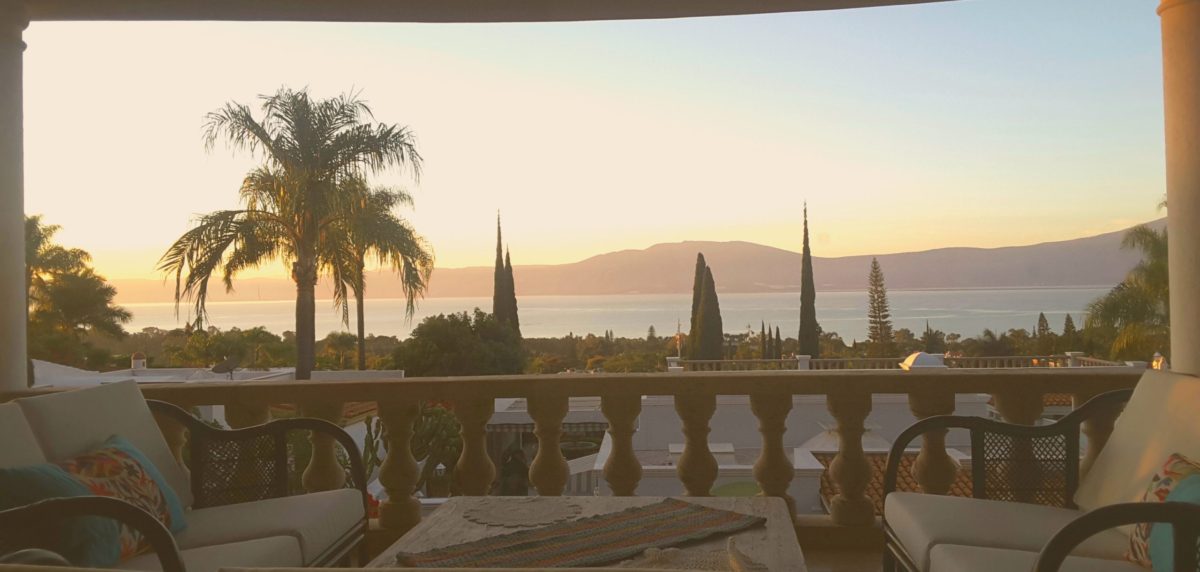
Lakeside is a world unto itself: a string of small Mexican towns with an equally large expat population. The villages lie along the north shore of Lake Chapala, and they are connected by a single road: the carretera or “main street” to those from NOB. This carretera is emblematic of small town Mexico: it is only two lanes wide with some parking as it runs through the village of Ajijic. Alongside most of the carretera there is also a paved strip called the ciclopista, or bike path. Except where it isn’t there.

Locals use the path to bike to/from work, or to walk to catch the busses which run along the carretera. Expats walk their dogs on it, jog or stroll on it, and sometimes drive golf carts down it. Motorcyclists use it to pass on the right, when they aren’t just passing on the right six inches from your car door. People park their cars on it in front of businesses in town. Where it is wider, as in the shaded area in La Floresta, people in a hurry drive down it, passing the slow crawl of cars stuck in the single (legal) driving lane.

The local government got a grant from the State to refurbish and improve the ciclopista. Previously, there was a variety of things delineating the ciclopista: concrete barriers, simple poles with reflectors, some trash cans with signs, some speed-bumps to let you know you were crossing the lane divide. Yet these were mostly permissive, in that they told you not to–but didn’t actually stop you from–driving there (as confirmed by the legendary tapatios who got tired of waiting in line and zoomed down it!).
Of course, before the work began, there was little civic engagement: suddenly, work teams started tearing up the road under banners proclaiming a State-funded refurbishment. Workers broke up asphalt, laid pipes, dug trenches and generally made a hash out of the one road which connects the communities Rumors abounded: they were laying fibre-optic cable (no) or widening the carretera to four lanes (no).

Soon the refurbishment began to take shape: the pipes were electric lines for new streetlights (a welcome addition, if true). The lights would be positioned among large concrete barriers which vaguely resemble World War II anti-tank obstacles. Oh, and amidst the concrete, small indentations for (wait for it) . . . planters!

With predictable results:

A Monster truck, which the crew was able to free! 
A water delivery truck, which wasn’t as lucky!
Here we are, months into ciclopista reconstruction.

Traffic remains stalled, although quite manageable if considered in NOB terms. Barriers have been erected, removed, and replaced. The government decide to have a meeting with local businesses. The first session was postponed due to overly large attendance and much yelling. At the second session, the government decided to let people vent for awhile, then displayed a master plan which is still unreleased. At least there was a plan!
I have to imagine that someone is getting paid by the yard for concrete, as there is way more being poured than is needed. Sometime they pour it, set it, and tear it back out, all in the same week. In the end, we’ll have a brand-new reserved lane for bicycles, pedestrians, and the occasional gringo who will try to drive down it.
When the local government first extended the ciclopista through Ajijic by removing a parking lane, locals predicted doom and destruction. But as you see by the photos, people still parked on it, and businesses still survived. While a concrete barrier will cut down on that, there will be delivery spaces according to the government. And I have yet to see a concrete barrier at the ends of the cross streets, meaning drivers could still drive down the ciclopista and park on it, which in Mexico, means they will.
How will it all turn out? ¿Quien sabe? In Mexico, nothing seems to happen for ages, then suddenly everything changes. People adapt, normalcy returns, and the cycle resumes.



